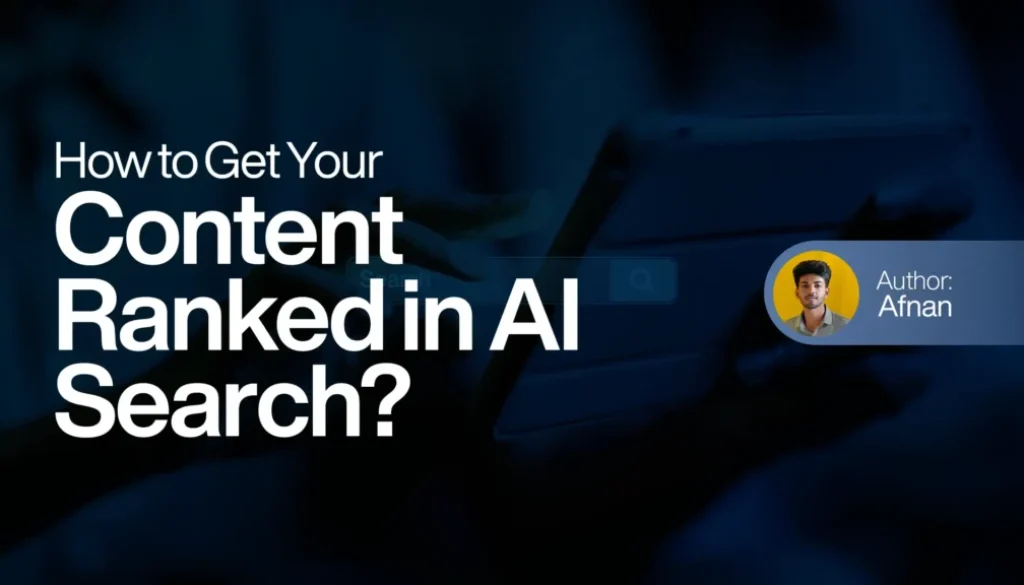How to Get Your Content Ranked in AI Search?
In 2025, your biggest SEO competitor might not be another brand — it could be an AI chatbot.
Let that idea settle.
Table of Content
As more people move from traditional search engines to AI tools such as ChatGPT, Gemini, and Perplexity, a new challenge is emerging: AI Search Optimization.
It’s no longer just about ranking first on Google — it’s about being the source that AI tools recommend, reference, and quote.
If you’re a marketer or business owner wondering how to appear when someone asks ChatGPT a question related to your area, this guide is for you.
What Is AI Search Ranking?
AI search ranking refers to how visible and recommended your content is in Ai search results
These models either:
– Pull from their training data
– Use real-time web searches
– Apply RAG (Retrieval-Augmented Generation) to find and combine up-to-date, reliable sources
Your goal is to become one such trusted source.
Why AI Ranking Matters
AI tools are now the new front page.
People ask questions directly in ChatGPT or voice assistants rather than using Google.
– One result usually matters. LLMs often show one source, which means you’re either featured or you’re not.
– No-click search is rising. Many users get answers directly from AI tools and don’t visit search engines.
Being mentioned in AI responses builds trust, brings traffic, and increases long-term visibility.
AEO + GEO = Visibility
Two key terms to know:
1. AEO (Answer Engine Optimisation)
This involves formatting your content to answer questions directly, for both users as well as AI tools.
Examples include featured snippets, FAQs, how-to guides, and direct answers.
2. GEO (Generative Engine Optimisation)
This goes beyond AEO. It focuses on structuring content for AI tools that answer, not just show them. It’s about making your content friendly, readable, and recommendable for AI.
Good Practices to Get Ranked in AI Search
1. Answer Real Questions:
Use tools like AlsoAsked, AnswerThePublic, or look through Reddit and Quora to find what people are genuinely asking. Then, answer those questions clearly in your content.
– Use H2 and H3 headings for each topic.
– Be direct and factual in your answers.
2. Use Schema Markup:
Structured data helps both search engines and AI tools understand your content.
Add schema for:
– FAQ
– HowTo
– Article
– Blogs
Use Google’s Rich Results Test to validate. Rich results are that show up in more engaging formats like images, videos, and carousels.
3. Improve Crawlability & Speed:
If AI tools are pulling data in real time, your site needs to be easily crawlable.
– Use clean URL structures.
– Fix broken links and redirects.
– Ensure fast load times (under 2 seconds).
– Submit XML sitemaps to search engines.
4. Publish Authoritative Content Hubs:
Don’t just write one article. Build a content hub around a theme.
For example:
– Main guide: “How AI Search Is Changing SEO”
– Supporting blogs: “Best Schema for AEO,” “How RAG Works,” “What Is GEO in SEO?
Link them internally to show depth.
This helps AI tools see you as a reliable authority in your niche.
5. Mention Your Brand in Credible Places:
AI tools like to reference credible sources. Get your brand mentioned in:
– Guest posts on relevant blogs
– Podcasts or webinars
– Industry roundups or news sites
– LinkedIn posts that get shared
Your domain and brand need to be visible across the web so that RAG-based models can discover you.
A RAG model, or Retrieval Augmented Generation model, is an AI framework that improves the accuracy and relevance of language models by combining them with an external source.
6. Create Content That’s Easy to Summarise:
AI tools work quickly. Provide them with content they can easily use.
– Use short paragraphs and bullet points.
– Include clear headings.
– Add summaries or TL; DRs at the top or bottom of content.
TL;DR – Too Long; Didn’t Read. It indicates lengthy text, and a summary is provided.
The easier it is for AI to understand your content, the more likely it is to feature you.
Advanced Technical Strategies
– Use canonicalization to avoid duplicate content confusion.
– Add alt text to images so AI can understand their content.
– Enable Open Graph and Twitter Cards to make your content look good when shared.
– Keep your site HTTPS and mobile-friendly.
– Add robots.txt file to guide crawlers, but don’t block helpful AI bots like GPTBot unless necessary.
Benefits of Ranking in AI Search
Qualified Traffic: Visitors are more intentional because they come from direct queries.
Trust Factor: Being cited by AI tools makes your brand seem more credible and neutral.
Low Maintenance: Once you’re cited, traffic can become passive — no need to constantly run ads.
Compounding Visibility: Once you’re cited once, more tools may start referencing you.
Conversation Ownership: You influence how AI talks about your topic.
That’s valuable branding.
Final Thoughts:
This Is Your Early Mover Advantage
AI search is growing rapidly. The marketers who understand this now will be ahead tomorrow.
It’s not just SEO anymore. Start now. Own your topic.
And let the AIs talk about you.



